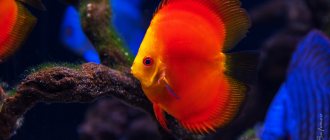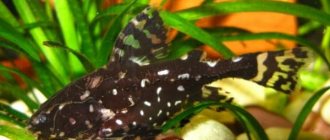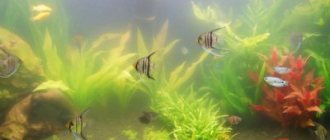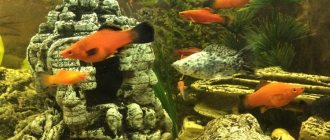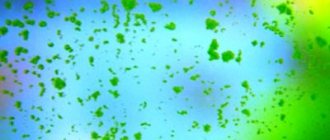Christmas moss (Christmas Moss) is an aquarium plant of the genus Vesicularium, the Hypnidae moss family, the Hypniaceae order, the subclass of the Brieaceae mosses. The natural habitat of this plant is springs and rivers of India, Brazil and Southeast Asian countries with fast flows and clean water enriched with oxygen.
Description
The plant has a central stem with small symmetrical shoots, the length of which smoothly decreases from the base of the stem to the tip. Tiny, round, pointed leaves with thin walls and veins sit tightly on the shoots. Hygrophyte has no roots. It is attached to the surface using microscopic suckers (rhizoids), invisible to the naked eye. The total height of the plant is 10 cm.
REFERENCE: Bryophyte did not receive its “festive” name by chance. Its stems, shoots and leaves form a trapezoidal shape that looks like a Christmas tree.
Return to content
Benefits of living plants
The main role of all aquarium plants is natural filtration. During the daytime, they absorb carbon dioxide and waste products of the inhabitants - organic and inorganic. In response, greenery enriches the environment with oxygen. By the way, it is vegetation that can quickly signal to a person that something is wrong with the microflora: a change in color, the appearance of plaque or the death of parts indicate an imbalance in the chemical balance.
Vegetation plays the role of shelter for fish that do not feel very comfortable in open space. Fry also like to hide in thickets. Also, the stems and leaves become an excellent spawning site, and for some, a fortified addition to the main diet.
Aquarium plants prevent the growth of algae - lower unicellular and multicellular organisms that harm the balance, fauna and other flora.
Do not forget that living plants also perform an aesthetic function. They look harmonious in design and give the aquarium the appearance of a real pond. The green color scheme can highlight the exotic colors of fish and other underwater pets.
This is interesting! Professional aquarists can unlock the potential of living vegetation to such an extent that they do not need mechanical filtration and aeration of the water.
Immediate family
Christmas moss is often confused with its close relative, Java moss. Indeed, these plants have a lot in common. But there are also differences, listed in the following table.
| Differences between Christmas and Java mosses | |
| Christmas | Javanese |
| branches are decorated with small symmetrical shoots | branches (shoots) have no shoots |
| long branches bend like a weeping willow | the branches are light, grow straight, do not bend down |
| light, bright color | dark color, medium brightness |
| growth is slow | growth is fast |
Both hygrophytes have valuable decorative properties, but thickets of Christmas moss require more careful care than the plantations of its Javanese relative.
Return to content
Cryptocorynes
Now - cryptocorynes . The vast majority of these amazingly diverse aroid plants, although they live in nature mainly along the shores of reservoirs, feel great when kept underwater. They are planted directly into the ground, placing the growing point (the core of the rosette) approximately at the level of the gravel surface. Unlike, for example, Echinodorus, Cryptocorynes do not shed damaged roots after transplantation, but preserve them, easily coping with their breakage. Therefore, the roots of these plants that are too long can be trimmed without fear with scissors before planting - this will not be a big injury for Cryptocoryne. But many cryptocorynes can partially shed their leaves due to stress during transplantation. Do not be alarmed by this phenomenon - very soon the leaves will grow again, larger and more beautiful than they were. Many species of cryptocorynes reproduce by stolons, similar to the “whiskers” of garden strawberries. Only, unlike strawberries, stolons do not spread over the surface, but inside the soil. So don’t be surprised if, after some time, you suddenly start to sprout here and there, sometimes quite far from the mother plants, small cryptocorynths. Large cryptocorynes are planted in the middle and background, filling the visual “bald spots” in the design with them, and small species are planted forward, not far from the viewing glass.
- Cryptocoryne Valkera yellow
- Cryptocoryne splendor
- Cryptocoryne Walker
- Cryptocoryne Wendta green
- Cryptocoryne curly
- Cryptocoryne related
- Cryptocoryne related
- Cryptocoryne ciliata
- Cryptocoryne pontederifolia
- Cryptocoryne Vendta dwarf
- Cryptocoryne Willis
- Cryptocoryne small (dwarf)
- Cryptocoryne hybrida
- Cryptocoryne Beckett
- Cryptocoryne cordate Blassa
- Cryptocoryne cordate
- Cryptocoryne Wendta brown
Conditions of detention
Moss is not picky about the composition of water; the main condition for its well-being is regular filtration. The following are the optimal conditions for the plant:
- permissible temperature 18-30◦C, optimal – 22-26◦C;
- acid-base balance (pH) 5.8-7.5 units;
- hardness (dH) 2-15 units;
- lighting 0.5-1.0 W per liter of water;
- mandatory: effective filtration;
- Desirable: CO2 supply.
ATTENTION: Moss loves crystal clear water and does not thrive in dirty, muddy environments. If you do not keep your aquarium clean, this wonderful herb will die very quickly.
Return to content
Hornwort
Hornwort dark green
Well, the last plant that we will need temporarily, at the first stage of the life of the aquarium, is the common hornwort . Big good bun. This unpretentious cosmopolitan plant, not distinguished by high aesthetic qualities, has one very important property for the successful start of an aquarium - it grows very quickly. So quickly that in the starting period, when the permanent plants are still sick, taking root and experiencing stress from transplantation, it takes over the initiative and does not allow lower algae to develop, starting the biochemical cycle of the aquarium.
Hornwort light green
© Aqua Logo Andrey Klochkov
To be continued…
The first part is devoted to preparing a “slow aquarium”, the third - the process of creating it, and the fourth - suitable fish for it.
Fields marked with * are required.
Reproduction
Under natural conditions, moss reproduces by spores. In an artificial reservoir it can be propagated using layering. You need to do this:
- select a suitable stem and divide it into several parts;
- dig several holes in the ground, according to the number of layers;
- place the cuttings in the holes and cover them with soil;
- Make sure that the bush does not float to the surface.
Return to content
Trimming
If the moss in the aquarium is not trimmed, its thick substrate will begin to rot. To prevent this from happening, it is necessary to regularly carry out complete or selective trimming of the plant. Solid trimming involves cutting the surface layer of moss. With selective trimming, only the excess branches of the plant are removed, and the bush takes on the shape that the aquarium owner needs.
ATTENTION: Branches cut off during trimming should be removed from the aquarium, and then partially change the water and thoroughly siphon the bottom. Otherwise, moss particles will grow in unplanned places.
Return to content
Artificial plants: pros and cons
Artificial vegetation is often used in aquadesign. It looks no worse than living flora and generally does not cause any harm to the ecosystem. There are other obvious advantages of plastic jewelry:
- They don't get sick or die;
- Does not require fertilizer, additional CO2 or bright light;
- Do not grow;
- They are not eaten by fish;
- Vegetation is easy to wash and remove plaque;
- Wide selection of colors and shapes to create a unique design.
It is worth remembering that living greens are an important element of biological balance. Without it, the aquarium is deprived of gas exchange (absorption of CO2 and production of oxygen from it) and natural filtration. Fish are deprived of a source of vitamins and minerals. Beneficial bacteria also lose the opportunity to develop a stable colony. However, there is no reason to say that artificial plants in an aquarium are bad.
Does your aquarium have live vegetation? And which type is your favorite? Share your stories in the comments to this article!
Use in aquascaping
Moss is well suited for landscaping caves, grottoes, stones and snags. To prevent the bush from floating up, it must be discreetly attached to the underwater object with fishing line.
Some aquarists create unusual vertical walls from moss. To do this, they fix a plastic mesh folded in half in the aquarium. Moss particles are placed inside the mesh. After some time, lacy leaves of moss form a green wall. Behind the overgrown leaves, the mesh becomes invisible.
Return to content
Christmas moss
Christmas moss photo
Family: Hypnaceae.
Origin: Asia.
Difficulty: Easy.
Conditions: temperature 22-27°C, KH 2-12°, pH 5-9. Lighting from 50 Lm/l.
Christmas moss, also known as Christmas moss (Vesicularia montagnei) - along with Java moss, one of the most common aquarium mosses. It is distinguished from Java moss by a more branched herringbone-shaped structure, which is where its name comes from.
Christmas moss is used as a smooth and logical transition from plants to decorations. Rocks and driftwood in an aquarium look more interesting and natural if you add moss to them.
Christmas moss is attached to surfaces using fishing line or thread. After some time, the moss attaches to the decoration and begins to bush. Further care of Christmas moss comes down to proper maintenance and cutting.
Christmas moss photo
However, Christmas moss grown in poor conditions (low light levels, lack of CO2, micro and macro fertilizers , high dH, infrequent water changes) is not as branched and is very difficult to distinguish from Java moss. In general, Christmas moss, like other aquarium mosses, is unpretentious.
Christmas moss photo
Filtration in an aquarium with mosses. An important issue when arranging a moss garden is high-quality filtration. Mosses do not tolerate excess organic matter and mechanical turbidity. The water in an aquarium with mosses must be perfectly clean. At the same time, excessive filtration (blowing) will also not contribute to the good health of mosses.
An important bonus of external filters is the “flute” attachment. Its use in an aquarium with mosses allows you to evenly distribute the flow of water and this is very important! After all, due to strong currents, Christmas moss “disintegrates” and does not grow.
In addition, installing a small internal filter with padding polyester filler will completely remove the slightest suspended matter.
Lighting in an aquarium with mosses. Like any representatives of the plant world, mosses love powerful lighting. If the lighting meets the proper characteristics, the mosses look lush and have a rich color. At the same time, most aquarium mosses cannot be called overly demanding in terms of lighting. And that’s why even beginners can handle them. Specific lighting power parameters for each aquarium are individual, the average value at which mosses feel good is ~ 0.5 Watt/liter or ~ 30-40 Lm/liter.
At the same time, it should be said that too much lighting will require the aquarist to pay more attention to the aquarium, as it can cause an algae outbreak.
Fertilizers for an aquarium with mosses. Christmas moss does not require root feeding, mainly because it does not have a root system. They take all micro and macro fertilizers from water. As a direct feed for mosses, you can use liquid fertilizers - Tetra PlantaPro Macro , Tetra PlantaPro Micro .
An important issue in the arrangement of moss gardens is the supply of CO2. Perhaps this is the most important fertilizer that any plant needs. In practice, it is known that many mosses are able to grow and develop without the supply of carbon dioxide. However, the proper concentration of CO2 will be favorably received by mosses. For these purposes, you can use mash or CO2 cylinders, or Tetra CO2 plus . Objectively, of course, Tetra CO2 plus cannot replace the supply of CO2 through a cylinder or brew. Nevertheless, it copes with the function declared by the manufacturer. It is also good that TetraCO2 plus is not an algaecide.
Christmas moss photo
To conclude this question, it is worth saying that mosses grow quite slowly, so the processes of their consumption of fertilizers are “slow”. From this we conclude that it is important not to allow an excess of fertilizers in the moss garden - “less is better, but more.”
Cool videos about plants from FanFishki
Subscribe to our YouTube channel so you don't miss anything
PRACTICAL NOTE ON GROWING AQUARIUM PLANTS
This note is posted in all FanFishka articles dedicated to aquarium plants. This is a cheat sheet with a link that will help you grow any aquarium plant and herbalist of any complexity.
Most of the reference materials are located in the Aquascape , we also recommend our brochure: Aquarium navigator for beginners: “Underwater Gardens of Babylon” .
The formula for success in growing plants can be depicted as follows.
First of all, the proper level of lighting is necessary.
(light intensity - Lumens)
Next, the proper concentration of CO2
Further macro-fertilizers and micro-fertilizers
Water parameters, care and quality water changes
The gradation of this formula is based on the degree of importance. Lighting intensity is primary, and then descending. Therefore, if your plants have holes in the leaves, they have sciatica (crooked) or there are problems with algae, then please do not read the “bad advice” - this is chlorosis (lack of iron), this is a lack of potassium... diarrhea, phimosis and endometriosis )
You always need to solve the problem of setting up an herbalist from major to minor. Plants will die more quickly from a lack of lighting than from a lack of Fe and K. Moreover, the latter are always present in one degree or another in the aquarium, but it is difficult to measure their precise value.
Below, let's go from the main to the minor.
Lighting in an aquarium with plants . Remember, the most important thing in light is its intensity (Lumens)! All other lighting characteristics: spectrum, Kelvin, PAR/PAR, Ra... are important, but secondary. There will be no intensity of lighting, there will be nothing. At the same time, the lighting intensity must be balanced - selected specifically for your project (height of the water column, number and types of plants, daylight hours).
Based on the above, choose aquarium lighting primarily by the number of lumens, and then everything else.
Lighting is the most expensive part. The most budget-friendly solution is to install ordinary construction-street floodlights above the aquarium . Fortunately, they are now very thin and aesthetic. And believe me, under them everything grows with a bang, of course, provided that all the other components are present.
In order not to be unfounded, here are photos of our herbalists, which were grown exclusively under LED spotlights or with their presence.
If you want professional lighting or aesthetics. Then you will have to fork out some money. The amounts can vary quickly from 10,000 to 50,000+ rubles for a 100 liter aquarium. For example, in 2021 we switched to professional lighting - ISTA Titan . Yes, not cheap, but the lamps are Achon! We have grown a professional competitive aquascape under them. That’s why we advise you to pay attention to them.
Well, it’s difficult to advise anything, because... Everyone has different needs and capabilities. In this article we talk about the products of our partners - Tetra , Laguna , ISTA lighting .
We tried to briefly and objectively talk about them. Then it's up to you. In any case, we do not really recommend that you pay attention to handicraft lighting assembly from folk craftsmen. Not all, but as a rule, they shove who knows what kind of diodes into such an assembly, assemble it all on their knees... and believe me, more than once on the forum you hear echoes of the consequences of such a purchase. After all, a company is a company. At a minimum, you are given warranty and post-warranty service.
If you are a beginner, your first herbalist, then LED spotlights are your choice. Let's move on, otherwise this note isn't very short =)
CO2 for aquarium plants . The plant is approximately 90% water, the remaining 10% is dry matter. Of that 10%, 46% is carbon. This is why CO2 supply is so important in a planted aquarium.
Plants in an aquarium obtain carbon “from water” - from carbon-containing compounds. But the natural concentration of C-carbon in water is small and is only sufficient for unpretentious plants, but they, and even more so, will be happy with additional carbon feeding. The supply of CO2 can be provided using mash or a CO2 balloon system , lemon juice or other methods.
The best, professional, simple and budget option is to supply carbon dioxide through a cylinder. One thing, however, is the initial purchase of a set: a cylinder, an MG valve, a diffuser…. will hit the budget.
Is it possible to do without CO2, but for a couple of bushes of simple plants ( cryptocorynes , echinodorus , most ludwigias , etc.).
What balloon systems can you recommend? The most budget option is an assembly from craftsmen who sell CO2 systems in VK and on forums. Everything is very high quality.
If you want a branded item, then we recommend the most inexpensive and at the same time high-quality CO2 systems from ISTA (Taiwan) . We have been using them for 5 years and recommend them to you.
On sale you will find two series of ISTA Aluminum CO2 Cylinder cylinders, with horizontal and vertical threads of 1 and 3 liters.
Fertilizers for an aquarium with plants . All fertilizers, of any brand, can be divided into MACRO-FERTILIZERS and MICRO-FERTILIZERS .
Macro fertilizers are nitrate NO3 and phosphate PO4 from which plants take N-nitrogen and P-phosphorus. These are the most important elements after CO2 - C-carbon.
Remember - Redfield's proportion rules . Always keep it under control and everything will be ok. Right, based on our observations, Redfield’s proportion rules only in full NPC proportions. Incomplete proportion - without carbon C does not give good results.
Micro fertilizers . These are all the other less important elements that are necessary for plants (see link). There is no point in putting too much emphasis on them. Firstly, all of them are contained in one quantity or another in tap water and are restored in the aquarium with changes. Secondly, an overdose of micro very quickly leads to an outbreak of algae.
A common mistake made by beginners is not understanding what they are pouring into the aquarium. For example, let's take such a popular and popular fertilizer as Tetra PlantaMin . Read the product summary at the link - it strengthens, stimulates, and gives a chic body shape.
A beginner, without delving into the essence, uses it and gets an outbreak of algae, writes on the forums - “Like, wow, what a bad Tetra.” And the trouble lies not in the drug, but in a lack of understanding of the nitrogen cycle and balance in the herbalist . The beginner has a Redfield bias (let’s say N and P are generally zero) and instead of making up for the lack of these primary elements, he fills the aquarium with Tetra PlantaMin - a micro-fertilizer (iron, potassium, manganese). As a result, going over the micro is only detrimental, because... plants lack the base - nitrogen and phosphorus.
Thus, you must understand what plants lack and understand fertilizers.
How to understand what plants lack? It's simple. Now the market is filled with a variety of expensive and not so expensive aquarium water tests. We recommend inexpensive domestic ones - VladOx drop tests , they are sold online and offline.
We also recommend, let’s not be afraid of this word, innovative domestic UHE tests . They are currently only sold online.
The minimum set of tests for an herbalist is NO3 and PO4. It is advisable to have the entire nitrogen range: NH4, NO2, NO3. As well as kH and pH tests.
Tests help us monitor the situation in the herbalist, but over time it is advisable to learn to see and feel the aquarium for yourself. With experience you need to move away from “convulsive testing”; the best aquarium test and tool is ourselves.
Let's summarize this part. Macro, it’s macro in Africa too. The link above generally contains a recipe on how to make them yourself. If you are not yet ready for self-mixing, then always and everywhere you will find a line of fertilizers from Tetra: Tetra Planta Macro , Tetra PlantaMicro , substrates, root tablets and much more .
Of course, there are many other brands that produce aquarium fertilizers. There is an opportunity, use even ADA products. All markers are different in taste and color. The main thing is to use it with a clear understanding of what you are using it for and what you want to get in the end.
From the professional line of fertilizers, at an adequate price, we can recommend Prodibo (soils, soils, macro, micro, stimulants, etc.).
So, something like a note turns into the Talmud. Which is not surprising - the topic is very broad. One moment left.
Water parameters for aquarium plants. Link1 and Link2 , please look at these articles, they cover the essence quite well.
Here we note that the quality of photosynthesis is influenced by the process of caring for the aquarium: water parameters (kH, pH below 7), high-quality filtration and aeration, competent and timely water changes.
Please study
Favorable neighborhood
Like other types of moss, Christmas moss gets along well with dwarf shrimp. Such a neighborhood is beneficial for both invertebrates and the plant: shrimp find reliable shelter and pasture here, and as a sign of gratitude they free the moss from food particles and other debris.
Christmas bryophyte is a rather rare plant that is valued for its decorative properties and accessible conditions of maintenance. This moss appeared in our country relatively recently. It is widely used in the aquarium hobby for landscaping underwater objects (grottoes, rocks, snags) and decorating vertical green walls.
Return to content
Liverwort - monosolenium (Monosolenium) or lomariopsis
Moss Monosolenium (Moss Liver)
Finally, the fourth plant that I highly recommend for a “slow” aquarium is the liverwort - Monosolenium or Lomariopsis. Outwardly, these species, which are actually very far from each other from the point of view of biological systematics, are almost the same, and they like the same conditions. These amazing plants have neither stems, nor leaves, nor roots - only a flat green thallus branching like deer antlers. Liverworts are very ancient plants, left over from the times when mosses and ferns made up the bulk of photosynthetic plants on Earth. The branching rather fragile segments of the liverwort form beautiful hemispherical hills or a solid green carpet on the bottom of the aquarium, gradually becoming thicker. At the same time, it is very loose, so it does not prevent young cryptocorynes from growing through it, debris from falling to the bottom, and dwarf aquarium loaches (acantophthalmus) and neocaridine shrimp from living inside this weave.
Moss Monosolenium on driftwood


